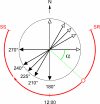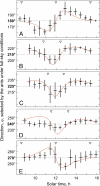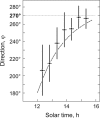The significance of direct sunlight and polarized skylight in the ant's celestial system of navigation
- PMID: 16888039
- PMCID: PMC1567920
- DOI: 10.1073/pnas.0604430103
The significance of direct sunlight and polarized skylight in the ant's celestial system of navigation
Abstract
As textbook knowledge has it, bees and ants use polarized skylight as a backup cue whenever the main compass cue, the sun, is obscured by clouds. Here we show, by employing a unique experimental paradigm, that the celestial compass system of desert ants, Cataglyphis, relies predominantly on polarized skylight. If ants experience only parts of the polarization pattern during training but the full pattern in a subsequent test situation, they systematically deviate from their true homeward courses, with the systematics depending on what parts of the skylight patterns have been presented during training. This "signature" of the polarization compass remains unaltered, even if the ants can simultaneously experience the sun, which, if presented alone, enables the ants to select their true homeward courses. Information provided by direct sunlight and polarized skylight is picked up by different parts of the ant's compound eyes and is channeled into two rather separate systems of navigation.
Conflict of interest statement
Conflict of interest statement: No conflicts declared.
Figures






References
-
- Santschi F. Rev. Suisse Zool. 1911;19:303–338.
-
- Santschi F. Mém. Soc. Vaud. Sci. Nat. 1923;4:127–175.
-
- von Frisch K. Experientia. 1949;5:142–148. - PubMed
-
- Rossel S. In: Facets of Vision. Stavenga D. G., Hardie R. C., editors. Berlin: Springer; 1989. pp. 298–316.
-
- Wehner R. In: Neural Basis of Behavioural Adaptations. Schildberger K., Elsner N., editors. Stuttgart: Fischer; 1994. pp. 103–143.
Publication types
MeSH terms
LinkOut - more resources
Full Text Sources
Research Materials

